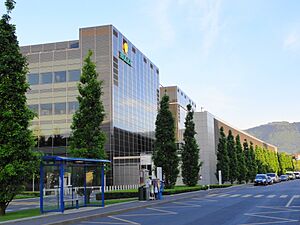Plan-les-Ouates facts for kids
Quick facts for kids
Plan-les-Ouates
|
||
|---|---|---|
 |
||
|
||
| Country | Switzerland | |
| Canton | Geneva | |
| District | n.a. | |
| Area | ||
| • Total | 5.85 km2 (2.26 sq mi) | |
| Elevation | 405 m (1,329 ft) | |
| Population
(Dec 2020 )
|
||
| • Total | 10,601 | |
| • Density | 1,812.1/km2 (4,693/sq mi) | |
| Postal code |
1228
|
|
| Surrounded by | Bardonnex, Carouge, Confignon, Lancy, Onex, Perly-Certoux, Troinex | |
| Twin towns | Villefranche-sur-Mer (France), Birsfelden (Switzerland) | |
Plan-les-Ouates is a town in the canton of Geneva in Switzerland. It's a busy place with many businesses and a growing population. The town is known for its beautiful location near the Rhone river.
Contents
History of Plan-les-Ouates
Plan-les-Ouates was first mentioned in records way back in 1537. Back then, it was called Plan-des-Vuattes.
It became its own independent town in 1851. This happened when a larger area called Compesières split up. That's when Plan-les-Ouates and Bardonnex became separate towns.
Geography and Location
Plan-les-Ouates covers an area of about 5.86 square kilometers (2.26 square miles). A large part of this land, about 44%, is used for farming. About 51% of the land has buildings and roads.
The town is located on the left side of the Rhone river. It includes the main village of Plan-les-Ouates. It also has smaller areas called hamlets like Arare and Saconnex d'Arve.
Other parts of the town include ZIPLO, Les Cherpines, Les Voirets, Le Sapey, Bois d'Humilly, Drize - La Chapelle, Saconnex d'Arve - Dessus, Champ-Gredin, Arare - Plein-Vent, and Arare - La Gravière.
Population and People
Plan-les-Ouates has a population of about 10,601 people. A good number of people living here, about 24.3%, are from other countries. Over the last ten years, the town's population has grown a lot, by about 58.5%.
Languages Spoken
Most people in Plan-les-Ouates speak French. About 86.6% of the population uses French as their main language.
Other languages spoken include German (about 4.2%) and Italian (about 2.2%).
Where People Come From
Many people living in Plan-les-Ouates were born there, about 16.6%. A larger group, about 37.4%, were born in the same canton (region). About 26.9% of the people were born outside of Switzerland.
Age Groups in the Town
The population of Plan-les-Ouates includes many young people. About 28% of the population are children and teenagers (0–19 years old). Adults (20–64 years old) make up 61.4% of the population. Seniors (over 64 years old) are about 10.6%.
Population Growth Over Time
The town's population has changed a lot over the years. You can see how it has grown in the chart below:

Foreign Residents in Plan-les-Ouates
Many people from other countries live in Plan-les-Ouates. Here are some of the largest groups of foreign residents:
| Nationality | Amount | % total (population) |
|---|---|---|
| 432 | 4.2 | |
| 408 | 4.0 | |
| 318 | 3.1 | |
| 184 | 1.8 | |
| 104 | 1.0 | |
| 85 | 0.8 | |
| 62 | 0.6 | |
| 53 | 0.5 | |
| 47 | 0.5 | |
| 45 | 0.4 | |
| 42 | 0.4 | |
| 41 | 0.4 | |
| 38 | 0.4 | |
| 34 | 0.3 | |
| 29 | 0.3 |
Important Heritage Sites
Plan-les-Ouates is home to some important historical places. The Forte D’Arare House is one of them.
Also, the archives (old records) of famous watchmakers like Patek Philippe SA and Vacheron Constantin are located here. These sites are considered important national heritage sites in Switzerland.
Twin Towns Around the World
Plan-les-Ouates has special friendships with other towns in different countries. These are called "twin towns."
|
Economy and Jobs
Plan-les-Ouates is a place with many jobs. In 2010, the unemployment rate was 6.4%. This means most people who wanted to work had a job.
Many people work in different types of businesses:
- Primary sector: A small number of people work in farming.
- Secondary sector: Many people work in factories (manufacturing) and construction.
- Tertiary sector: The largest number of jobs are in services. This includes sales, transportation, hotels, restaurants, and healthcare. Many technical and scientific jobs are also in this sector.
Many people travel into Plan-les-Ouates for work every day. About 2.5 workers come into the town for every one worker who leaves. Most people use private cars to get to work, but many also use public transportation.
Religion in Plan-les-Ouates
According to a census in 2000, many people in Plan-les-Ouates are Roman Catholic (about 44.5%). Another large group belongs to the Swiss Reformed Church (about 18.6%).
There are also smaller groups of people who follow other Christian churches, Islam, and Judaism. Some people do not belong to any church.
Education and Schools
Plan-les-Ouates has a good education system. Many adults have finished high school or gone on to higher education like university.
In the 2009-2010 school year, there were over 2,700 students in the town's schools.
- Young children can attend two years of non-required Kindergarten.
- Students then go to six years of primary school.
- After primary school, there are three years of required secondary school.
- Students can then choose to go to three to five years of advanced schools or professional training programs.
Many students from Plan-les-Ouates also attend schools outside the town.
Images for kids
See also
 In Spanish: Plan-les-Ouates para niños
In Spanish: Plan-les-Ouates para niños





